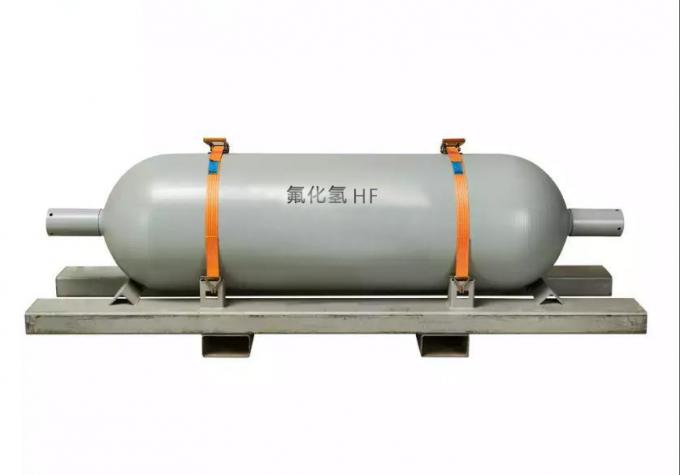


| MOQ: | 1kg |
| Price: | US $15/kg |
| Standard Packaging: | Cylinder/Tank |
| Delivery Period: | 15 days |
| Payment Method: | L/C, T/T |
| Supply Capacity: | 20000 Tons/Year |
Hydrogen fluoride (HF) is a chemical compound consisting of hydrogen (H) and fluorine (F) atoms. It is an inorganic acid with a strong acidic nature. Here are some key points about hydrogen fluoride:
Properties: Hydrogen fluoride is a colorless liquid or a gas at room temperature, depending on the pressure. It has a sharp, pungent odor and is highly soluble in water. HF is highly corrosive and can react with many materials, including metals, glass, and ceramics.
Production: Hydrogen fluoride can be produced through various methods. One common method involves the reaction of calcium fluoride (CaF2) with sulfuric acid (H2SO4). The reaction produces calcium sulfate (CaSO4) and releases hydrogen fluoride gas. Other methods involve the reaction of fluorite (CaF2) with concentrated sulfuric acid or the reaction of fluorapatite (Ca5(PO4)3F) with sulfuric acid.
Uses: Hydrogen fluoride has several applications in different industries:
Chemical Industry: HF is used as a catalyst or reactant in various chemical reactions, including the production of fluorocarbons, fluoropolymers, and pharmaceuticals. It is also employed in the petroleum refining industry for alkylation processes.
Glass Etching: Hydrogen fluoride is commonly used for etching or engraving glass. It reacts with the silica (SiO2) in glass, creating a frosted or matte appearance on the surface.
Metal Surface Treatment: HF is used for cleaning and surface treatment of metals, particularly in industries such as electronics and semiconductor manufacturing. It can remove oxide layers and impurities from metal surfaces.
Laboratory Applications: Hydrogen fluoride is utilized in laboratories for various purposes, such as analytical chemistry, sample preparation, and glassware cleaning.
Safety Considerations: Hydrogen fluoride is highly corrosive and toxic. It can cause severe burns to the skin, eyes, and respiratory system. Inhalation or exposure to HF vapor or liquid can result in serious health effects. Proper safety precautions, such as the use of protective equipment, ventilation, and proper handling procedures, should be followed when working with hydrogen fluoride.
It is crucial to handle hydrogen fluoride with extreme care and adhere to strict safety protocols and regulations due to its hazardous nature.
Basic Info.
| Model No: | HF | Purity | 99.95%% |
| Transport Package | ISO Tank/Cylinder | Specification | ISO Tank/Cylinder |
| Appearance | CMC | Origin | Suzhou,China |
| HS Code | 2812190091 | Production Capacity | 30000 Metric Ton Per Year |
Specification:







| MOQ: | 1kg |
| Price: | US $15/kg |
| Standard Packaging: | Cylinder/Tank |
| Delivery Period: | 15 days |
| Payment Method: | L/C, T/T |
| Supply Capacity: | 20000 Tons/Year |
Hydrogen fluoride (HF) is a chemical compound consisting of hydrogen (H) and fluorine (F) atoms. It is an inorganic acid with a strong acidic nature. Here are some key points about hydrogen fluoride:
Properties: Hydrogen fluoride is a colorless liquid or a gas at room temperature, depending on the pressure. It has a sharp, pungent odor and is highly soluble in water. HF is highly corrosive and can react with many materials, including metals, glass, and ceramics.
Production: Hydrogen fluoride can be produced through various methods. One common method involves the reaction of calcium fluoride (CaF2) with sulfuric acid (H2SO4). The reaction produces calcium sulfate (CaSO4) and releases hydrogen fluoride gas. Other methods involve the reaction of fluorite (CaF2) with concentrated sulfuric acid or the reaction of fluorapatite (Ca5(PO4)3F) with sulfuric acid.
Uses: Hydrogen fluoride has several applications in different industries:
Chemical Industry: HF is used as a catalyst or reactant in various chemical reactions, including the production of fluorocarbons, fluoropolymers, and pharmaceuticals. It is also employed in the petroleum refining industry for alkylation processes.
Glass Etching: Hydrogen fluoride is commonly used for etching or engraving glass. It reacts with the silica (SiO2) in glass, creating a frosted or matte appearance on the surface.
Metal Surface Treatment: HF is used for cleaning and surface treatment of metals, particularly in industries such as electronics and semiconductor manufacturing. It can remove oxide layers and impurities from metal surfaces.
Laboratory Applications: Hydrogen fluoride is utilized in laboratories for various purposes, such as analytical chemistry, sample preparation, and glassware cleaning.
Safety Considerations: Hydrogen fluoride is highly corrosive and toxic. It can cause severe burns to the skin, eyes, and respiratory system. Inhalation or exposure to HF vapor or liquid can result in serious health effects. Proper safety precautions, such as the use of protective equipment, ventilation, and proper handling procedures, should be followed when working with hydrogen fluoride.
It is crucial to handle hydrogen fluoride with extreme care and adhere to strict safety protocols and regulations due to its hazardous nature.
Basic Info.
| Model No: | HF | Purity | 99.95%% |
| Transport Package | ISO Tank/Cylinder | Specification | ISO Tank/Cylinder |
| Appearance | CMC | Origin | Suzhou,China |
| HS Code | 2812190091 | Production Capacity | 30000 Metric Ton Per Year |
Specification:





